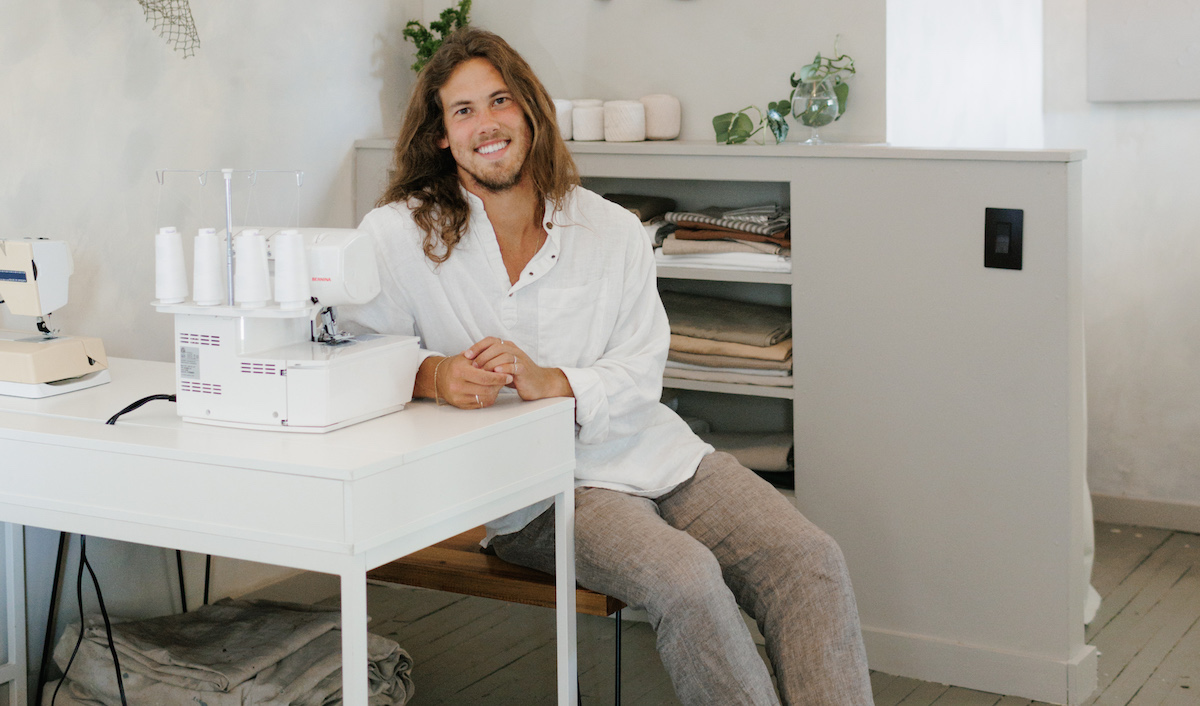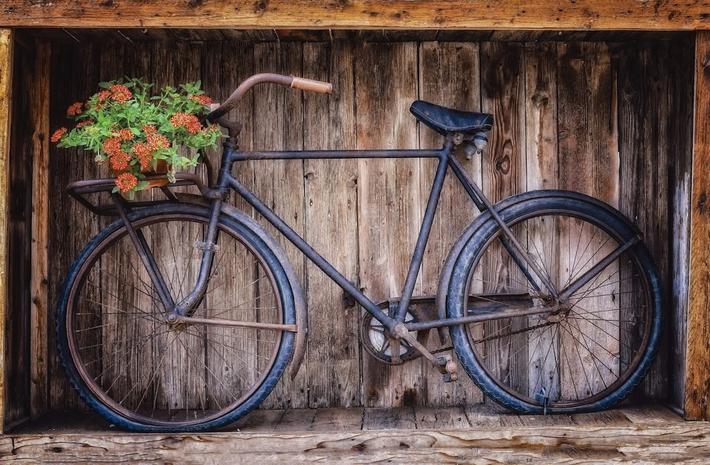
Elijah Nykamp: Turning Clothing into Confidence
How this Suttons Bay designer turned a thrifting hobby into a thriving new boutique
By Craig Manning | Nov. 25, 2023
“I think there’s a lot in the fashion world that makes people feel really, really bad about themselves. My goal is the complete opposite.”
So says Elijah Nykamp, the owner, visionary, designer, sewist, and sole employee of nykamping. The boutique store, which opened its doors in downtown Suttons Bay this past July, “originated from a love both for oversized outerwear and thrifting—along with the desire to take textile sustainability, circular fashion, ethically sourced, and zero waste to its absolute max.” The shop specializes in roomy, one-of-a-kind clothing that stays true to nykamping’s tagline: “A tent for your body.”
Nykamp, who hand-sews every nykamping piece himself from a mix of reclaimed and repurposed textiles, sees his work as mission-driven, and a lot of that mission has to do with rejecting the norms of the fashion world. In pushing people to keep up with the latest trends or align with certain body types or standards of beauty, Nykamp says fashion can have the effect of putting people down. His goal, always, is to lift them up.
“I want to help people take back that control,” Nykamp explains. “Instead of having clothes that wear you, and that dictate how you feel, I want you to have clothes that allow you to exude confidence and show people who you are. With my pieces being oversized and being one-size-fits-most, their job is not meant to give you an hourglass shape or be traditionally ‘flattering.’ Their job is to exhibit creativity. Their job is to be a conversation-starter. Their job is to let someone’s personality really shine through.”
Chasing the Muse
That concept, of letting your personality shine through no matter what, doubles as the key takeaway from Nykamp’s journey in business so far.
Up until a few years ago, Nykamp was headed for a career as a teacher. In 2018, he earned his bachelor’s degree in early childhood education from Hope College and then spent the next year teaching kindergarten at a school in Nigeria.
“But I realized in that year that, while I loved working with the kids, the pieces that I enjoyed the most were around creating,” he says. “I knew I wanted to do more design work.”
Rather than push that impulse down, Nykamp took a leap of faith. He moved to Leelanau County and started investing more of his time on creative pursuits. He had a “day job” to pay the bills—a three-and-a-half-year stint as a house parent and later, head of house, at The Leelanau School. But the job afforded him more free time than a teaching gig, and soon, he was planting the seeds that would become nykamping.
“I don’t have a degree in design, or in sewing, or garment production, or fashion, or anything like that,” Nykamp says. “It’s all skills that I was taught as a child by my mom and then picked up way more intensely during COVID, when all of us were figuring out what we actually really liked to do with our extra time.”
The other piece of the puzzle, Nykamp says, came from simply spending time in thrift stores and developing both an eye for style and an idea of what he wanted his brand to be.
“During COVID, I was buying and selling thrifted clothing,” he says. “I was finding really great pieces and just reselling them on my Instagram. Soon, I started to alter pieces. I’d do a new hemline, or change up shirts in different ways, and I started to sell those designs. Now, in the past year, I’ve finally started to get into garment production and designing my own pieces from scratch.”
Earlier this year, Nykamp jumped at a chance to take his all-online business into the world of brick-and-mortar retail. A space opened up in downtown Suttons Bay, just a few blocks from his apartment, and he snagged it. That gearshift into public-facing retail happened much quicker than Nykamp expected, a timeline shakeup he describes as “deciding to push my five-year dream to a six-month dream.”
Finding an Audience
While the quick transition from online seller to main street retailer has brought a few growing pains, Nykamp says it’s also offered incredibly gratifying evidence that he made the right choice in giving up his original career path to chase his muse.
This summer, for instance, in his first two weeks with a storefront, Nykamp sold through half his inventory. And while sales have slowed down a bit in the off-season, Nykamp says he’s still getting plenty of foot traffic. Perhaps more importantly, the slowdown of the fall has offered more opportunities for Nykamp to build connections with the community.
“I realized through the summer that, yes, it’s really nice to have a lot of sales; those are obviously important,” Nykamp tells Northern Express. “But a successful day, to me, is so much more than the number of sales. I’ve had great talks with customers about textile sustainability, about body positivity, and about the jobs that clothes have. People are coming through with great ideas, and I’ve loved getting their perspectives.”
All those talks have also given Nykamp a chance to master a core skill he says is crucial to nykamping’s success: multitasking. As the business’s lone employee, Nykamp runs the shop and creates the pieces—often at the same time.
“The multitasking is honestly a very special element of my storefront and my business,” Nykamp says. “If you come into the shop, you get the full picture of what’s going on here. There’s no behind-the-scenes stuff. There’s no partition. People who see me working at my sewing machine know that I’ve had my hand in every single one of the pieces on the floor.”
Lake Letters and Heirloom Quilts
It’s a lot of pieces, too. Late in the summer, for instance, Nykamp launched “lake letters,” a 39-piece collection named after and inspired by a book of poems and essays from Empire-based writer and photographer Mae Stier. Described as “flowy, calming, sustainable, and one of a kind,” the collection incorporated patterns, colors, textures, and an overall aesthetic that mimicked the look of northern Michigan waves, shorelines, and sand dunes.
Now, with winter closing in, Nykamp is on to his next collection: “heirloom,” a run of “weekly Friday mini-drops” featuring new pieces made from quilts. “I have been accumulating quilts for years, not quite sure what I wanted to end up doing with them,” Nykamp says. The popularity of an earlier collection—which turned quilts into coats—gave him the idea.
“Quilts tell us stories,” he says. “There’s so much history in them. Especially in Michigan and throughout the Midwest, it’s normal to have quilts that are gifted to children or passed down through generations. I wanted to celebrate that history and heritage, and because the quilts I’m using were either donated by local people or sourced locally, it feels cool to have them filtering back into the community that they came from.”
Quilts also have the benefit of being a very obvious embodiment of Nykamp’s principles when it comes to sourcing fabrics as ethically as possible. In the description for the heirloom collection on the nykamping website, Nykamp writes that quilts are “society’s longest example of slow fashion, unique design, and leisure home textiles”—all attributes that make them perfect for his unique approach to clothing design.
The Slow Fashion Ideal
As nykamping becomes more of a known commodity in the northern Michigan community, one benefit for Nykamp is that, now, instead of having to go out and hunt down textiles, the fabrics are coming to him.
Before he opened his storefront, Nykamp would take regular treks to secondhand shops like Samaritan’s Closet and the Women’s Resource, hunting down materials that were “local and pre-loved.” He still does that, to a certain extent, but now, customers are also bringing him bags of textiles, from quilts to secondhand clothing to little fragments of unused fabric.
For Nykamp, that trend of customer behavior is a sign that locals are embracing a new cycle for their clothing habits—one that rejects the wasteful, pollutive, factory-to-landfill arc that has long defined fast fashion.
Even beyond Nykamp’s sourcing of fabrics and his penchant for recycling and repurposing, “slow fashion” is an apt way to describe the nykamping approach. Some items in the store, Nykamp says, took 15-20 hours to make. The prices on the clothes reflect all that work and all that time—and help explain why Nykamp is so passionate about each garment finding the right person, and vice versa.
“I believe that fashion is art and fashion is choices,” Nykamp says. “People who end up purchasing my pieces, that is a really intentional thing—both because of the financial investment, but also because of the confidence it takes to make that fashion choice. I like knowing that someone is so in love with the piece that they’re ready for tons of comments.”
Those comments come because nykamping designs tend to stand out instead of blending in. For Nykamp, though, that impossible-to-miss quality is the beauty not just of the work itself, but also the customer who decides to buy it.
“I recently heard from a woman who bought a piece from me, and she wore it on a road trip from here all the way to California,” Nykamp says. “She said she got compliments or someone talking to her about that coat in every state she stopped in. You might not get that if you were making a more subdued fashion choice. So, I love thinking that, for the people who are purchasing my pieces, it’s an opportunity for them. It’s an opportunity to exude confidence, to draw people’s eyes, and to make people jealous, saying, ‘Wow, I wish I felt like I could pull something like that off.’”
See more at nykamping.com. Photo by Mae Stier.
Trending

Walking in an Artsy Wonderland
Michigan Legacy Art Park is hosting the “Raindrops” artwork created by Dewey Blocksma and Patricia Innis at th... Read More >>
Seven Takeaways from Local Real Estate Agents for the Spring/Summer Market
The last few years in local real estate have been akin to what one local agent described as the “wild west,” w... Read More >>
Blazing the Boyne City to Charlevoix Trail
We’re getting ever closer to an interconnected northern Michigan thanks to ongoing work on the Boyne City to Charlev... Read More >>


